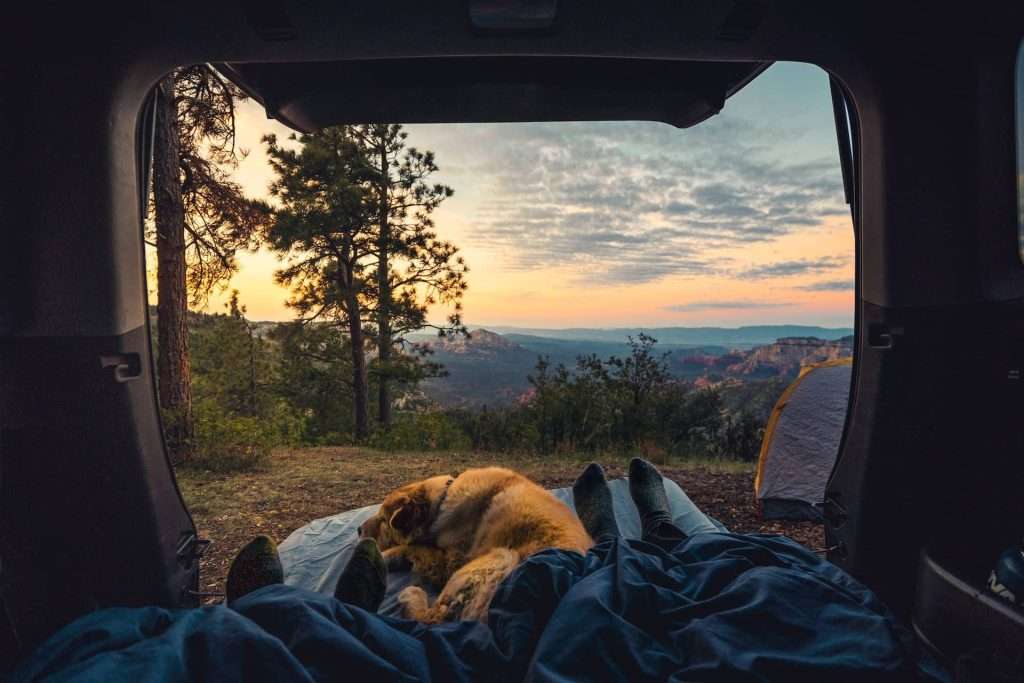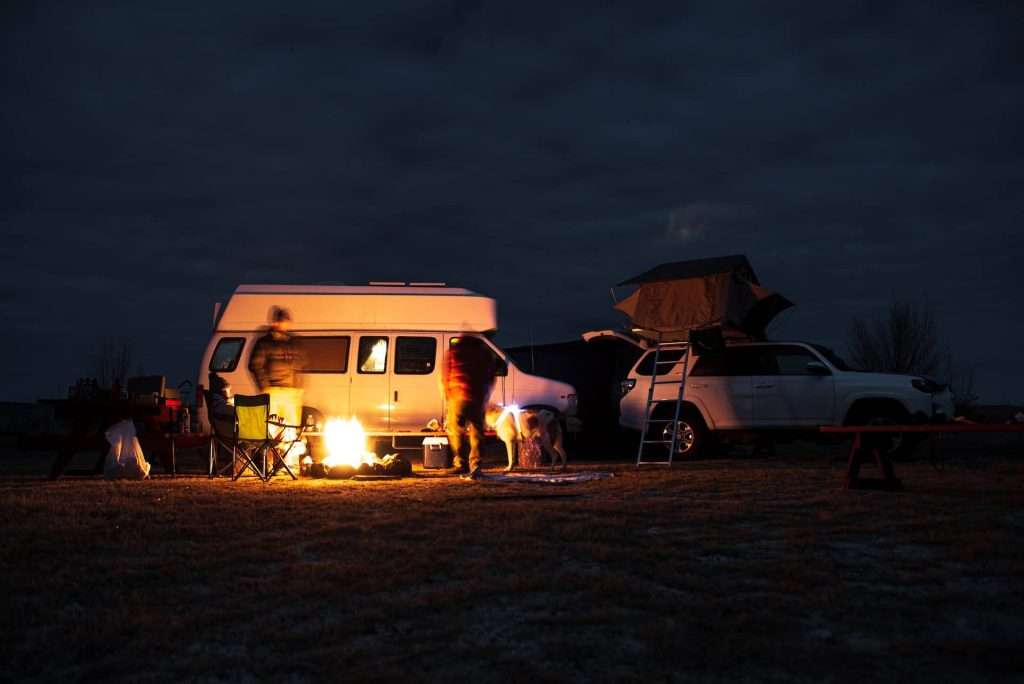
The Ultimate Guide To RVing With A Dog
As an avid RV enthusiast who has just about seen it all, RVing with a dog has been one of the most rewarding and unforgettable experiences throughout my journeys.
RVing with a dog opens up a whole new world of adventure, exploration, and bonding, making each trip a tail-wagging delight. Throughout this guide, we will delve into the ins and outs of RVing with a dog, sharing invaluable tips and insights to ensure you and your furry friend have the time of your lives on every road trip.
From choosing the perfect RV to exploring dog-friendly destinations, from preparing your canine co-pilot for RV life to maintaining a pet-friendly RV lifestyle, and from ensuring your dog’s health and safety on the road to packing all the essentials, get ready to embark on an unforgettable journey filled with wagging tails and endless memories!

Choosing The Right RV For You And Your Dog
RVing with a dog requires thoughtful consideration when selecting the perfect recreational vehicle to accommodate your needs and your furry companion’s comfort. With a wide array of RV types available, each offering different features and layouts, making a well-informed decision to ensure an enjoyable journey for both of you is essential.
Pet-Friendly RV Types
When RVing with a dog, certain types of RVs are more pet-friendly than others. Class C motorhomes and travel trailers are popular choices for dog owners due to their relatively spacious interiors and convenient floor plans. These options provide ample space for your dog to move around comfortably during travel, and they often come with slide-outs that expand the living area, giving your pup more room to stretch out.
Features Catering To Dogs
Look for RVs with features specifically designed to cater to dogs. Some manufacturers have started incorporating pet-friendly amenities like built-in pet beds, water and food bowl stations, and even outdoor pet showers, making it easier to clean your dog after muddy adventures. Additionally, RVs with easily accessible storage compartments can be beneficial for keeping dog supplies organized and accessible.
Size, Layout, And Amenities
Consider the size and layout of the RV with your dog in mind. While larger dogs may feel more comfortable in Class C motorhomes with spacious living areas, smaller dogs might enjoy cozy travel trailers or even converted vans. Look for models with vinyl or laminate flooring that are easier to clean in case of accidents or muddy paws. A layout that allows easy access to the door without disturbing your dog’s resting spot can be advantageous during quick stops.
Adequate ventilation is crucial for RVing with a dog, especially during warm weather. Look for RVs with multiple windows and ventilation fans to keep the interior cool and well-ventilated for your furry friend. Additionally, having a designated space for your dog’s crate or bed can help establish a familiar and secure environment, making them feel more at ease during the journey.
Before finalizing your choice, consider your dog’s size, temperament, and mobility. Some dogs may prefer a lower entry step to access the RV, while others might not mind climbing a few stairs. Keep in mind any special needs your dog may have and ensure the RV’s amenities cater to those requirements.
Preparing Your Dog For RV Life
Preparing your canine companion for RV life is crucial in ensuring a smooth and enjoyable journey when RVing with a dog. Just like humans, dogs need time to acclimate to their new surroundings and feel comfortable in the confined space of an RV. By following a few essential tips, you can make the transition to RV life a positive and stress-free experience for your furry friend.
Introducing Your Dog To The RV
The first step in preparing your dog for RVing is introducing them to the RV itself. Start by letting your dog explore the RV while it’s parked in a familiar and safe environment, such as your driveway or backyard. Allow them to sniff around and get used to the new scents and surroundings. Reward positive behavior with treats and praise to create positive associations with the RV.
Gradually increase your dog’s time in the RV, while trying your best to make it a fun and exciting experience. Consider playing with them or providing their favorite toys inside to make the RV a place of enjoyment.
Creating A Familiar And Safe Space
Designate a specific area within the RV for your dog where they can have their own space to rest and feel secure. This could be a cozy corner with their bed or a comfortable crate if they are crate-trained. A familiar item, like their favorite blanket or toy, will also help your dog feel at ease in the new environment.
Before hitting the road, ensure that all potentially hazardous items (such as cleaning supplies or sharp objects) are safely stored away, and secure any loose items that could fall or move during travel.
Crate Training For Travel
If your dog is not already crate-trained, consider crate training them for RV travel. A properly sized and comfortable crate can provide a sense of security during the journey, preventing your dog from feeling overwhelmed by the constant movement of the RV. Crate training can also benefit dogs that are prone to anxiety or motion sickness during travel.
Start crate training well before your trip, gradually allowing your dog to get accustomed to spending time in the crate. Make the crate a positive space by providing treats, toys, and praise when they enter voluntarily.
Ensuring Their Security
During travel, always secure your dog properly inside the RV to ensure their safety. Use a sturdy harness or crate that is appropriately sized and anchored to prevent any potential injuries or accidents. Never allow your dog to roam freely inside the RV while it is in motion, as sudden stops or turns can pose risks.
Remember that some dogs may take time to adjust to the movement and sounds of the RV. Be patient and observe their behavior during the initial trips, making adjustments as needed to ensure their comfort and well-being.
By gradually introducing your dog to the RV, creating a familiar and secure space, and providing proper crate training for travel, you’ll set the foundation for an enjoyable and stress-free RVing experience together. With time, patience, and plenty of positive reinforcement, your dog will embrace RV life as their new adventure-filled home on wheels.
Dog-Friendly Destinations And Campgrounds
When RVing with a dog, exploring dog-friendly destinations and campgrounds adds an extra layer of excitement and joy to your adventures. Thankfully, numerous pet-friendly RV parks and campgrounds are out there, catering to the needs of pet owners and their four-legged companions. These destinations offer a plethora of activities, making them the perfect spots for you and your furry friend to create lasting memories together.
Before starting your journey, research and compile a list of pet-friendly RV parks along your route. Look for establishments that not only allow dogs but also provide amenities specifically for them, such as fenced dog runs, pet waste stations, and pet-friendly cabins.
When making reservations, it’s essential to inform the campground about your furry companion’s presence, as some places have specific rules or limitations regarding pet stays. Being upfront about traveling with a dog will help ensure a smooth check-in process and guarantee a suitable spot for you and your canine companion.
Many campgrounds are located near beautiful hiking trails that welcome leashed dogs. Additionally, dog parks near campgrounds allow your dog to socialize and burn off energy in a safe, enclosed space. If you’re venturing near coastal areas, look for dog-friendly beaches where your pup can frolic in the sand and surf. Many beaches have designated dog-friendly areas, providing the perfect opportunity for you and your dog to enjoy the sun and sea together.
Health And Safety On The Road
When RVing with a dog, ensuring their health and safety on the road is paramount. Just like humans, dogs can face unexpected health challenges during travel, making it essential to be prepared and proactive in safeguarding their well-being. By creating a comprehensive doggy first-aid kit and understanding potential health risks in different regions, you can be equipped to handle emergencies and prioritize your furry companion’s safety.
Doggy First-Aid Kit
A well-stocked doggy first-aid kit is an essential companion for any RVing adventure. Here are some items to include in your kit:
- Basic medical supplies: Gauze, bandages, antiseptic wipes, adhesive tape, and scissors.
- Tweezers: For removing ticks or splinters.
- Thermometer: To monitor your dog’s temperature.
- Styptic powder: To stop bleeding from minor cuts.
- Saline solution: For rinsing wounds or eyes.
- Hydrogen peroxide: For inducing vomiting under veterinary guidance.
- Any necessary medications: Bring your dog’s regular medications and any prescribed by your veterinarian for travel-related issues.
- Vet contact information: Have the contact details of local veterinarians along your route in case of emergencies.
Be sure to familiarize yourself with the contents of the first-aid kit and know how to use each item appropriately. Additionally, take the time to learn basic first-aid procedures for dogs, such as CPR and wound care, in case immediate action is required.
Responding To Common Pet Emergencies
Being knowledgeable about how to respond to common pet emergencies can be life-saving during your RVing journey. Common emergencies may include heatstroke, dehydration, insect stings, or minor injuries from outdoor activities.
If your dog shows signs of distress, such as excessive panting, weakness, or vomiting, seek shade and provide water immediately. Use the items in your doggy first-aid kit to administer first aid as needed, and contact a local veterinarian for guidance.
Understanding Potential Health Risks
Different regions may present unique health risks for your dog. Before traveling to a new area, research potential hazards, such as tick-borne illnesses, poisonous plants, or venomous wildlife. Take preventive measures, such as using tick preventatives and keeping your dog away from unfamiliar plants and wildlife.
Moreover, consider the climate and weather conditions of your destinations. High temperatures can lead to heat-related illnesses, while cold weather might require extra precautions to keep your dog warm and comfortable.
Ensure your dog stays hydrated during your travels, providing access to fresh water at all times, especially during outdoor activities. Monitor their behavior closely and adjust their activities according to the weather and temperature to avoid health issues.
Traveling With Dogs On The Road
Traveling with dogs on the road while RVing can be a delightful experience. However, it requires careful planning and consideration to ensure your furry friend’s comfort and well-being throughout the journey. By following best practices for long drives and implementing a thoughtful exercise routine, you can keep your dog happy, relaxed, and ready to enjoy every moment of your RV adventure together.
Best Practices For Long Drives
Long drives in an RV can be tiring for everyone, including dogs. So, it’s crucial to prioritize your dog’s comfort during travel. Here are some best practices to consider:
- Secure Your Dog: Always ensure your dog is safely secured inside the RV during transit. Utilize a pet seat belt harness, a travel crate, or a designated pet travel area that prevents them from wandering or being thrown around in case of sudden stops or turns.
- Comfortable Seating: Create a comfortable and familiar spot for your dog to rest during the journey. Place their bed, blanket, or favorite toy in their designated area to provide a sense of security.
- Adequate Ventilation: Keep the RV well-ventilated during travel to maintain a comfortable temperature for your dog. Avoid leaving them alone in the RV during extreme weather conditions.
- Avoid Motion Sickness: Some dogs may experience motion sickness during travel. To help prevent this, avoid feeding your dog a large meal just before hitting the road. Also, consider initially acclimating them to short trips to see how they handle the motion.
Regular Pit Stops And Exercise
Like their owners, dogs need regular breaks to stretch their legs, relieve themselves, and burn off excess energy. Plan for frequent pit stops along your route, preferably every two to three hours, to allow your dog to take a walk and have a potty break.
Look for pet-friendly rest areas, dog parks, or nature spots where your dog can safely explore and enjoy some playtime. Engaging in physical activities during breaks can help reduce restlessness and ensure your dog stays happy and content throughout the journey.
Additionally, incorporate exercise routines into your daily RVing schedule. Take advantage of the outdoor opportunities available at campgrounds, such as hiking trails or open spaces where your dog can run and play. Regular exercise will keep your dog physically fit and contribute to their mental well-being, making them calmer and more relaxed during travel.
Be mindful of your dog’s health and limitations, especially if they are seniors or have certain medical conditions. Adjust the exercise routine accordingly to suit their needs and energy levels.
Addressing The Challenges Of A Pet-Friendly RV Lifestyle
Maintaining a pet-friendly RV lifestyle while RVing with a dog involves addressing various challenges that come with having a furry companion on board. From managing pet hair and muddy paws to keeping your RV clean, adopting a few practical strategies will help create a harmonious and enjoyable environment for you and your canine co-pilot.
Pet Hair
Dogs naturally shed, and pet hair can quickly accumulate inside the RV. To minimize pet hair, groom your dog regularly and invest in a good-quality pet brush to remove loose fur. Place washable dog blankets or covers on furniture and bedding to protect them from excess hair.
Muddy Paws
Outdoor adventures can lead to muddy paws, which can be challenging to manage inside the RV. Keep a towel or pet wipes by the door to wipe your dog’s paws before they enter the living space. Consider using a portable pet paw washer to clean their paws thoroughly before letting them inside.
Keeping Your RV Clean
Regular cleaning is essential when RVing with a dog. Vacuuming, dusting, and mopping regularly will help maintain a clean and hygienic living environment for both you and your furry companion. Use pet-friendly cleaning products that are safe for your dog and the RV’s surfaces.
Packing Essentials For Your Dog
When RVing with a dog, packing the right essentials is crucial to ensure your furry friend’s comfort, safety, and well-being throughout the journey.
Creating a comprehensive checklist of dog-specific items and implementing space-saving storage solutions will help you stay organized and make the most of the limited space in your RV.
Comprehensive Checklist Of Dog-Specific Items
To ensure you have everything your dog needs during the trip, create a dedicated checklist for their essentials. Here are the must-have items for every RVing adventure with your dog:
- Food And Water: Pack an ample supply of your dog’s regular food, treats, and fresh water. Consider storing the food in airtight containers to keep it fresh and prevent spills.
- Food And Water Bowls: Collapsible or compact food and water bowls are perfect for RVing, as they take up minimal space when not in use.
- Leash And Harness: Bring a sturdy leash and a well-fitting harness to ensure your dog’s safety during walks and outdoor activities.
- Collar With ID Tag: Make sure your dog wears a collar with an up-to-date ID tag containing your contact information.
- Bedding And Blankets: Provide your dog with a cozy and familiar bed or blanket for them to rest on inside the RV.
- Crate Or Travel Carrier: If your dog is crate-trained or requires a safe space during travel, bring a suitable crate or travel carrier.
- Toys And Entertainment: Pack your dog’s favorite toys and entertainment items to keep them engaged and mentally stimulated.
- Waste Bags: Bring a sufficient supply of waste bags to clean up after your dog during walks.
- First-Aid Kit: As mentioned in the previous section, include essential pet first-aid supplies to handle minor injuries or emergencies.
- Medication And Medical Records: Don’t forget any necessary medication and your dog’s medical records in case you need to visit a veterinarian during the trip.
Space-Saving Storage Solutions
In an RV, storage space is limited, so it’s essential to utilize it efficiently. Consider the following space-saving solutions for your pet-related supplies:
- Collapsible Containers: Use collapsible containers for pet food and water bowls, making it easy to store them when not in use.
- Hanging Organizers: Install hanging organizers inside cabinets or closet doors to store small items like toys and grooming supplies.
- Under-Bed Storage: Utilize the space under the bed or seating areas to store larger items like bedding, crates, or extra food.
- Stackable Bins: Invest in stackable bins or containers to organize pet food, treats, and other supplies neatly.
- Multi-Functional Items: Opt for multi-functional pet items, such as a travel bed that can double as a crate or a leash that can be used as a tie-out.
- Portable Storage Bags: Use portable storage bags for items like toys or grooming supplies, which can be easily moved around and stowed away.
Final Thoughts About RVing With A Dog
RVing with a dog is a rewarding experience that fosters a unique bond between pet owners and their loyal canine companions. I’ve covered all of the essential aspects of RVing with a dog — now it’s up to you to implement these practices and follow these guidelines during your travels.
By preparing your furry friend for the journey, incorporating best practices for long drives and exercise routines, and addressing challenges like pet hair and muddy paws, we ensure our beloved pets are comfortable, content, and safe throughout our adventures together.
RVing with a dog opens up a world of possibilities, where wagging tails and joyful barks become the soundtrack of unforgettable moments on the open road!











